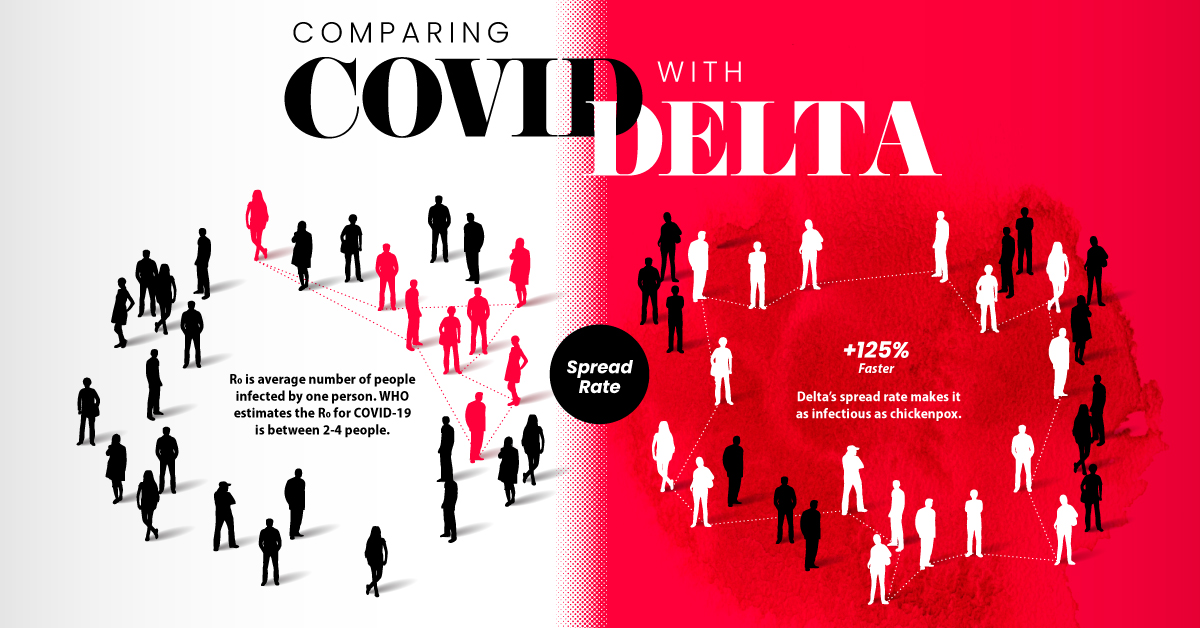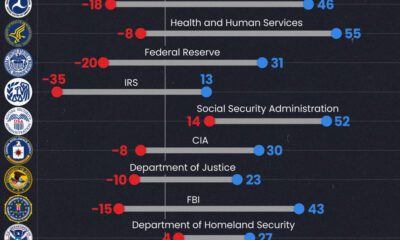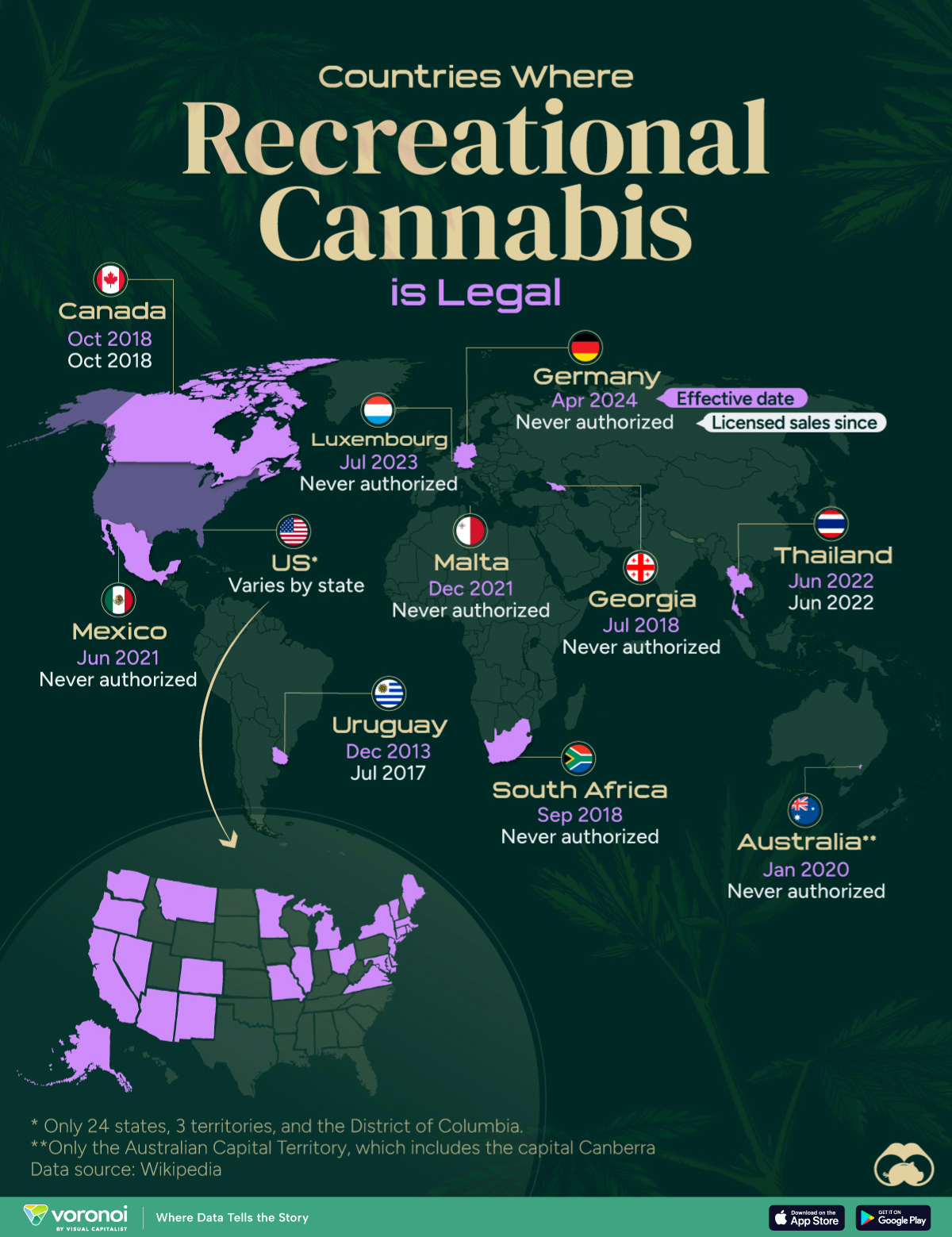Healthcare
How Does the COVID Delta Variant Compare?
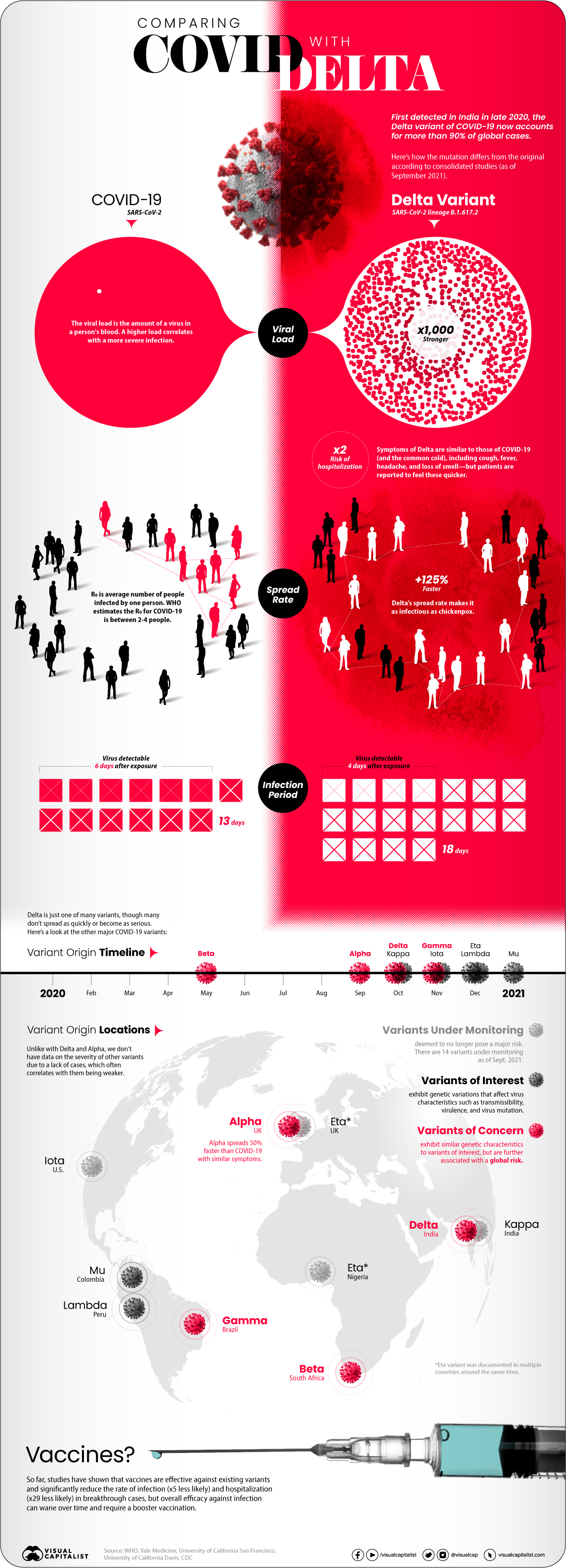
How Does the COVID Delta Variant Compare?
In late 2020, a variant of COVID-19 was detected in India that began to quickly spread.
Soon after it received the label “Delta,” it started to become the predominant strain of COVID-19 in countries of transmission. It spread faster than both the original disease and other variants, including “Alpha” that had taken hold in the UK.
Now the COVID-19 pandemic has essentially become the Delta pandemic, as the variant accounts for more than 90% of global cases.
But how does the COVID-19 Delta variant differ from the original disease? We consolidated studies as of September 2021 to highlight key differences between COVID-19 and the dominant variant. Sources include the CDC, Yale Medicine, and the University of California.
COVID-19 vs COVID-19 Delta Variant
At first glance, infections caused by the Delta variant are similar to the original COVID-19 disease. Symptoms reported from patients include cough, fever, headache, and a loss of smell.
But studies showed that the difference was in how quickly and severely patients got sick:
- Spread rate: How quickly the infection spreads in a community (based on the R0 or basic reproductive number). The Delta variant spread 125% faster than the original disease, making it potentially as infectious as chickenpox.
- Viral load: How much of a virus is detectable in an infected person’s blood, with higher loads correlating with more severe infections. Delta infections had a 1000x higher viral load.
- Virus detectable: How long after exposure a virus is detectable in an infected person’s blood. Delta infections were found to be detectable four days after exposure, faster than the original disease (six days).
- Infectious period: How long an infected person has the capability to pass on the virus to other people, from the first time they were exposed. Delta infections were contagious for longer than traditional COVID-19 infections, at 18 days compared to 13 days.
- Risk of hospitalization: How much more or less likely is an infection going to require hospitalization for treatment? Infections caused by the Delta variant were twice as likely to cause hospitalization compared to the original disease.
One other important finding from studies was that the existing COVID-19 vaccines helped against Delta infections.
The CDC found that approved vaccines reduced the rate of infection by 5x and the rate of hospitalization by 29x in a breakthrough case. They also found that overall efficacy against infection can wane over time, however, and at-risk people might require a booster vaccine.
What About Other COVID-19 Variants?
Delta is just one of many COVID-19 variants tracked by health officials, but it’s the one we know the most about.
That’s because reliable statistics and information on diseases requires thousands of cases for comparisons. We know a lot about Delta (and the once-dominant UK strain Alpha) because of how widespread they became, but there haven’t been enough cases of other variants to reliably assess differences.
As of September 2021, WHO was tracking 20 COVID-19 variants around the world with different classifications based on potential severity:
- 14 Variants under monitoring (VUM): Variants that are deemed to not pose a major global health risk, or no longer pose one.
- 2 Variants of Interest (VOI): Variants that affect transmissibility, virulence, mutation, and other virus characteristics, and are spreading in clusters.
- 4 Variants of Concern (VOC): Have similar characteristics to VOI but are further associated with a global risk.
Most of the current variants of interest and concern were first identified and labeled in late 2020, though 2021 variants are showing up as well.
| Label | Designation | Documented Origin | Earliest Identified Date |
|---|---|---|---|
| Alpha | Variant of Concern | UK | September 2020 |
| Beta | Variant of Concern | South Africa | May 2020 |
| Gamma | Variant of Concern | Brazil | November 2020 |
| Delta | Variant of Concern | India | October 2020 |
| Lambda | Variant of Interest | Peru | December 2020 |
| Mu | Variant of Interest | Colombia | January 2021 |
Should you be worried about all of these variants? For the most part, a lack of cases to provide clear information also reflects that they’re equivalent to or weaker than traditional COVID-19 infections.
But it’s important to note that our understanding of diseases and variants becomes more nuanced and accurate over time. As research continues over a longer timeline and over a wider database of cases, expect information on COVID-19 variants (and any disease) to become more concrete.
United States
Mapped: Countries Where Recreational Cannabis is Legal
In total, only nine countries have fully legalized recreational cannabis use.
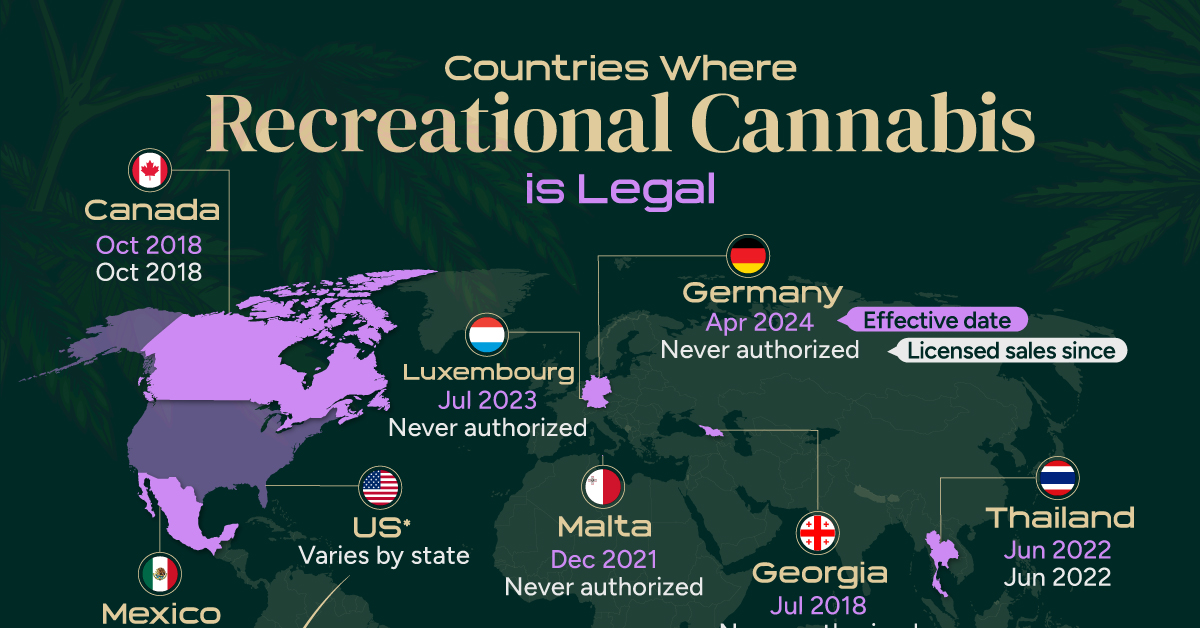
Countries Where Recreational Cannabis is Legal
This was originally posted on our Voronoi app. Download the app for free on iOS or Android and discover incredible data-driven charts from a variety of trusted sources.
In 2024, Germany became the third European Union country to legalize cannabis for personal use, following Malta and Luxembourg.
Here, we map the countries where recreational cannabis use is allowed as of April 2024, based on data from Wikipedia.
Limited to Few Countries
In total, only nine countries have legalized recreational cannabis use nationwide. However, just a few of them have licensed sales.
| Country | Effective date | Licensed sales since |
|---|---|---|
| 🇺🇾 Uruguay | December 2013 | July 2017 |
| 🇬🇪 Georgia | 30 July 2018 | Never authorized |
| 🇿🇦 South Africa | 18 September 2018 | Never authorized |
| 🇨🇦 Canada | 17 October 2018 | 17 October 2018 |
| 🇲🇽 Mexico | 28 June 2021 | Never authorized |
| 🇲🇹 Malta | 14 December 2021 | Never authorized |
| 🇹🇭 Thailand | 9 June 2022 | 9 June 2022 |
| 🇱🇺 Luxembourg | 21 July 2023 | Never authorized |
| 🇩🇪 Germany | 1 April 2024 | Never authorized |
| 🇺🇸 U.S. | Varies by state | Varies by state |
| 🇦🇺 Australia | Varies by jurisdiction | Never authorized |
At the federal level, cannabis is still considered an illegal substance in the United States. That said, individual states do have the right to determine their laws around cannabis sales and usage. Currently, cannabis is allowed in 24 states, 3 territories, and the District of Columbia.
Interestingly, the oldest legal text concerning cannabis dates back to the 1600s—when the colony of Virginia required every farm to grow and produce hemp.
Since then, cannabis use was fairly widespread until the 1930s when the Marihuana Tax Act was enforced, prohibiting marijuana federally but still technically allowing for medical use.
Today, the U.S. cannabis market is a $30 billion business. By the end of the decade, that number is expected to be anywhere from $58 billion to as much as $72 billion.
Similar to the U.S., Australia does not allow the use at the national level, but cannabis can be used legally in the Australian Capital Territory, which includes the capital Canberra.
-

 United States1 week ago
United States1 week agoMapped: Countries Where Recreational Cannabis is Legal
-

 Healthcare2 weeks ago
Healthcare2 weeks agoLife Expectancy by Region (1950-2050F)
-

 Markets2 weeks ago
Markets2 weeks agoThe Growth of a $1,000 Equity Investment, by Stock Market
-

 Markets2 weeks ago
Markets2 weeks agoMapped: Europe’s GDP Per Capita, by Country
-

 Money2 weeks ago
Money2 weeks agoCharted: What Frustrates Americans About the Tax System
-

 Technology2 weeks ago
Technology2 weeks agoCountries With the Highest Rates of Crypto Ownership
-

 Mining2 weeks ago
Mining2 weeks agoWhere the World’s Aluminum is Smelted, by Country
-

 Personal Finance2 weeks ago
Personal Finance2 weeks agoVisualizing the Tax Burden of Every U.S. State




